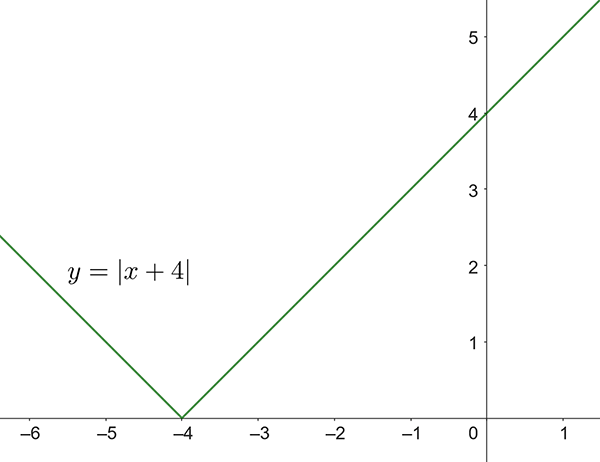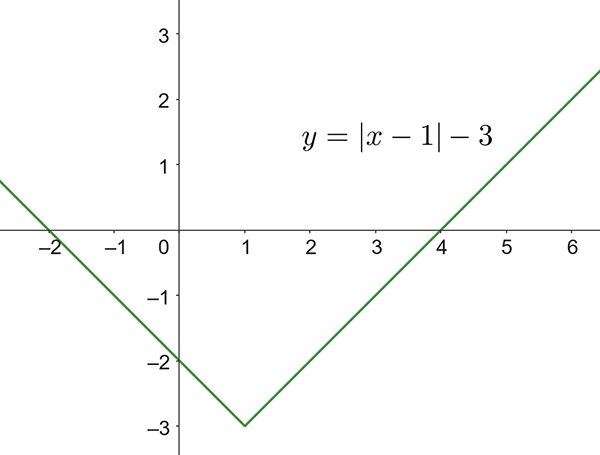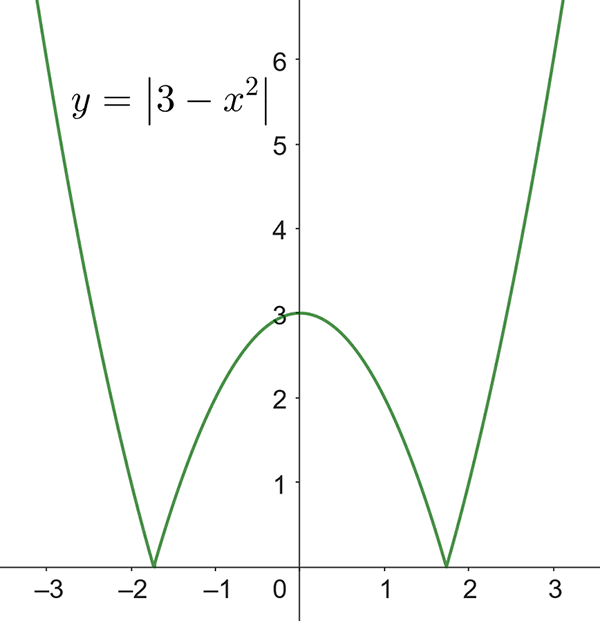FG4 Absolute value functions
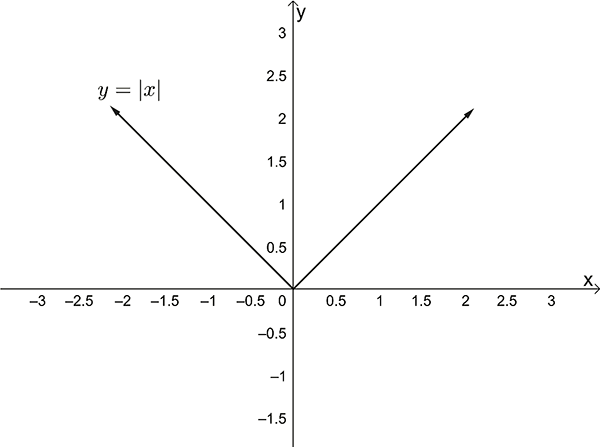
The absolute value of a number x gives a measure of its size or magnitude regardless of whether it is positive or negative. If a number is plotted on a number line then its absolute value can be considered to be the distance from zero.
Introduction
The absolute value of a number gives a measure of its size or magnitude regardless of whether it is positive or negative.
If a number is plotted on a number line then its absolute value can be considered to be the distance from zero.
The absolute value of a number or a pro-numeral is designated by two vertical lines such as \(\left|\,\cdot\,\right|\). For example the absolute value of the pro-numeral \(x\) is \(\left|x\right|.\)
Examples
\(\left|2\right|=2\)
\(\left|-2\right|=2\)
\(\left|-4+3\right|=\left|-1\right|=1\)
\(\left|-8\right|+\left|-1\right|=8+1=9\)
\(\left|x\right|=7\) \(\Rightarrow\) \(x=7\) or \(x=-7\)
The Absolute Value Function and its Graph
The absolute value function is a hybrid function1 A hybrid function involves two or more cases. Each case depends on the domain of the function. defined as follows:2 In what follows, \(\mathbb{R}\) is the set of real numbers.
\[\begin{align*} f:\mathbb{R}\rightarrow\mathbb{R},\textrm{where $f(x)=$ $\left|x\right|$ } & =\begin{cases} -x, & x<0\\ x & x\geq0 \end{cases} \end{align*}\]
with graph

The domain of \(f(x)\)=\(\left|x\right|\) is \(\mathbb{R}\) and the range of \(f(x)\) is \(\mathbb{R}^{+}\cup\left\{ 0\right\}\). That is the set of all positive real numbers and zero.
The graph of \(y=\left|x\right|\) may be translated in the same way as the graphs of other functions. Compare the graphs of the following functions with that of \(y=\left|x\right|\)
- The graph of \(y=\left|x-2\right|\) is shown below

and is the graph of \(y=\left|x\right|\) translated horizontally two units to the right. 3 The graph of \(y=\left|x+2\right|\) is the graph of \(y=\left|x\right|\) shifted two units to the left.
- The graph of \(y=\left|x\right|+1\) is shown below
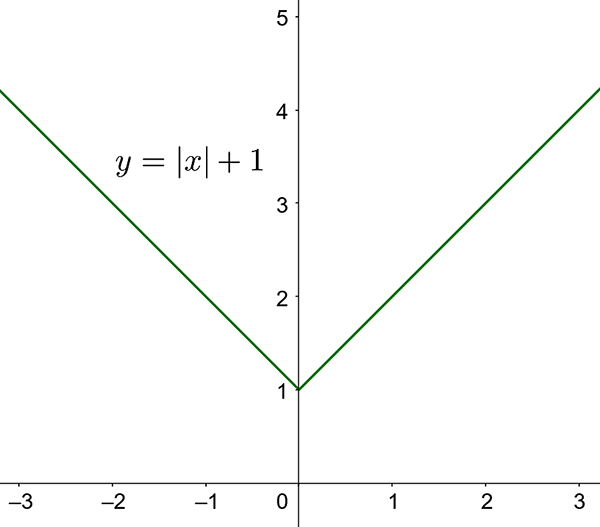
and is the graph of \(y=\left|x\right|\) translated vertically one unit up. 4 The graph of \(y=\left|x\right|-1\) is the graph of \(y=\left|x\right|\) translated vertically one unit down.
- The graph of \(y=3-\left|x\right|=-\left|x\right|+3\) is shown below
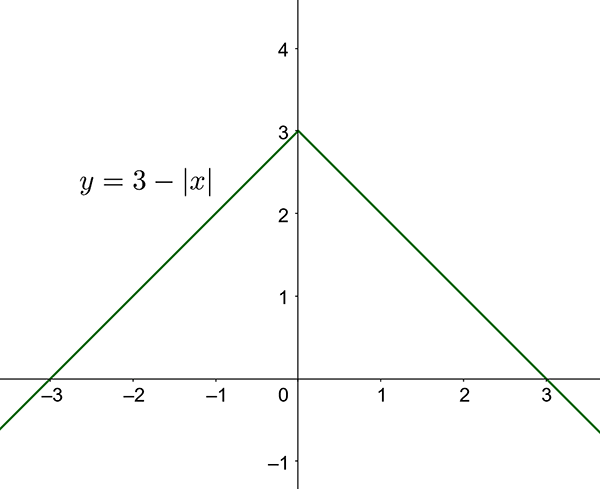
and is the graph of \(y=\left|x\right|\) reflected in the \(x\) axis followed by a vertical shift of three units up.
In general, to sketch the graph of \(y=\left|f\left(x\right)\right|\), we need to sketch the graph of \(y=f\left(x\right)\) first and then reflect in the \(x\)-axis the portion of the graph which is below the \(x\)-axis.
- Sketch \(\left\{ \left(x,y\right):y=\left|x^{2}-1\right|\right\}\)
The graph of this function is the graph of \(y=x^{2}-1\) with the portion below the \(x\)-axis reflected in the \(x\)-axis and is shown below:
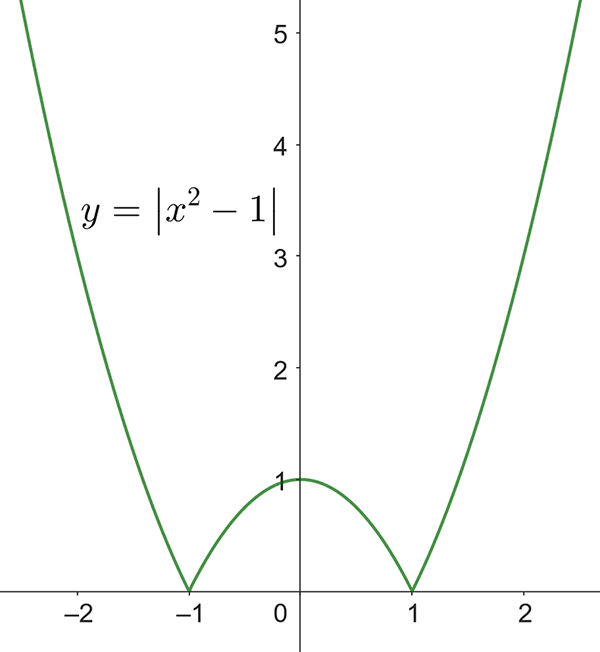
Equations and Inequalities Involving \(\left|f\left(x\right)\right|\)
Because \(y=\left|f\left(x\right)\right|\) is a hybrid function, two cases must be considered when solving equations and inequalities.
Examples
- Solve \(\left|x-2\right|=3\)
Solution:
If \(\left|x-2\right|=3\) we must consider the two cases: \[\begin{align*} x-2 & =3\\ x & =3+2\\ & =5 \end{align*}\] and \[\begin{align*} x-2 & =-3\\ x & =-3+2\\ & =-1. \end{align*}\]
Hence the answer is \(x=-1\) and \(x=3.\)
- Solve \(\left|2x+1\right|=\left|x-5\right|\).
Solution:
With an absolute value expression on each side of the equation it is easier to square both sides.
\[\begin{align*}
\left|2x+1\right| & =\left|x-5\right|\\
\left(2x+1\right)^{2} & =\left(x-5\right)^{2}\\
4x^{2}+4x+1 & =x^{2}-10x+25\\
4x^{2}+4x+1-x^{2}+10x-25 & =0\\
3x^{2}+14x-24 & =0\\
(3x-4)(x+6) & =0
\end{align*}\] So \[\begin{align*}
3x-4 & =0\\
x & =\frac{4}{3}
\end{align*}\] or \[\begin{align*}
x+6 & =0\\
x & =-6.
\end{align*}\] Hence the answer is \(x=4/3\) and \(x=-6.\)
- Find the set of \(x\in\mathbb{R}\) such that \(\left|\frac{2-x}{3}\right|<4\).
Solution: 5 Care must be taken when multiplying or dividing an inequality by a negative number. In such cases the inequality is reversed. The answer to this type of question is in fact a set as it involves an infinite number of solutions.
We have
\[\begin{align*} \left|\frac{2-x}{3}\right| & <4. \end{align*}\] Multiplying each side by \(3:\) \[\begin{align*} \left|2-x\right| & <12 \end{align*}\] and so
\[\begin{align*} -12<2-x & <12. \end{align*}\] Adding \(2\) to all sides we get: \[\begin{align*} -14<-x & <10. \end{align*}\] Multiplying by \(-1\), and noting the reversal of the inequality signs,
\[\begin{align*} 14>x & >-10\,\textrm{ or }-10<x<14. \end{align*}\] Hence the answer is that \(x\) is greater than \(-10\) but less than \(14\) \(.\) More formally, this may be expressed as a set \[\begin{align*} \left\{ x\in\mathbb{R}:-10<x<14\right\} . \end{align*}\]
- Find the set of \(x\in\mathbb{R}\) such that \(\left|\frac{x-2}{3}\right|\geq2\).
Solution:
Multiply both sides by \(3\) to get \[\begin{align*} \left|x-2\right| & \geq6. \end{align*}\] Hence \[\begin{align*} x-2 & \geq6\\ x & \geq8 \end{align*}\] or \[\begin{align*} x-2 & \leq-6\\ x & \leq-4. \end{align*}\] Hence the answer is \[\begin{align*} \left\{ x:x\leq-4\right\} & \cup\left\{ x:x\geq8\right\} . \end{align*}\]
Exercise 1
Evaluate:
\(\text{a) $\left|-11\right|\quad\text{b) $\left|-9+4\right|\quad\text{c) $-\left|4\right|-\left|-5\right|\quad\text{d) $\left|-12\right|-\left|3\right|\quad\text{e) $\left|-30\right|\div\left|5\right|$ }$ }$ }$ }$ }\)
\(\text{a) $11\quad\text{b) $5\quad\text{c) $-9\quad\text{d) $9\quad\text{e) $6$ }$ }$ }$ }$ }\)
Exercise 2
Sketch the graph of
\(\text{a) $y=\left|x+4\right|\quad\quad\text{b) $y=\left|x-1\right|-3\qquad\text{c) $y=\left|3-x^{2}\right|$ }$ }$ }\)
Exercise 3
Find for \(x\in\mathbb{R}\)
\(\text{a) $\left\{ x:\left|x\right|=6\right\} $ }\)
\(\text{b) $\left\{ x:\left|x-1\right|<3\right\} $ }\)
\(\text{c) $\left\{ x:\left|\frac{x-3}{2}\right|\geq1\right\} $ }\)
\(\text{d) $\left\{ x:\left|\frac{x}{2}\right|=\left|x+2\right|\right\} $ }\)
\(\text{a}.\ \left\{ -6,6\right\} \quad\text{b}.\ \left\{ x:-2<x<4\right\} \quad\text{c}.\ \left\{ x:x\leq1\right\} \cup\left\{ x:x\geq5\right\} \quad\text{d}.\ \left\{ -4,-\frac{4}{3}\right\}\)
Download this page, FG4 The Absolute Value Function (PDF 403 KB)
What's next... FG5 Hybrid functions

